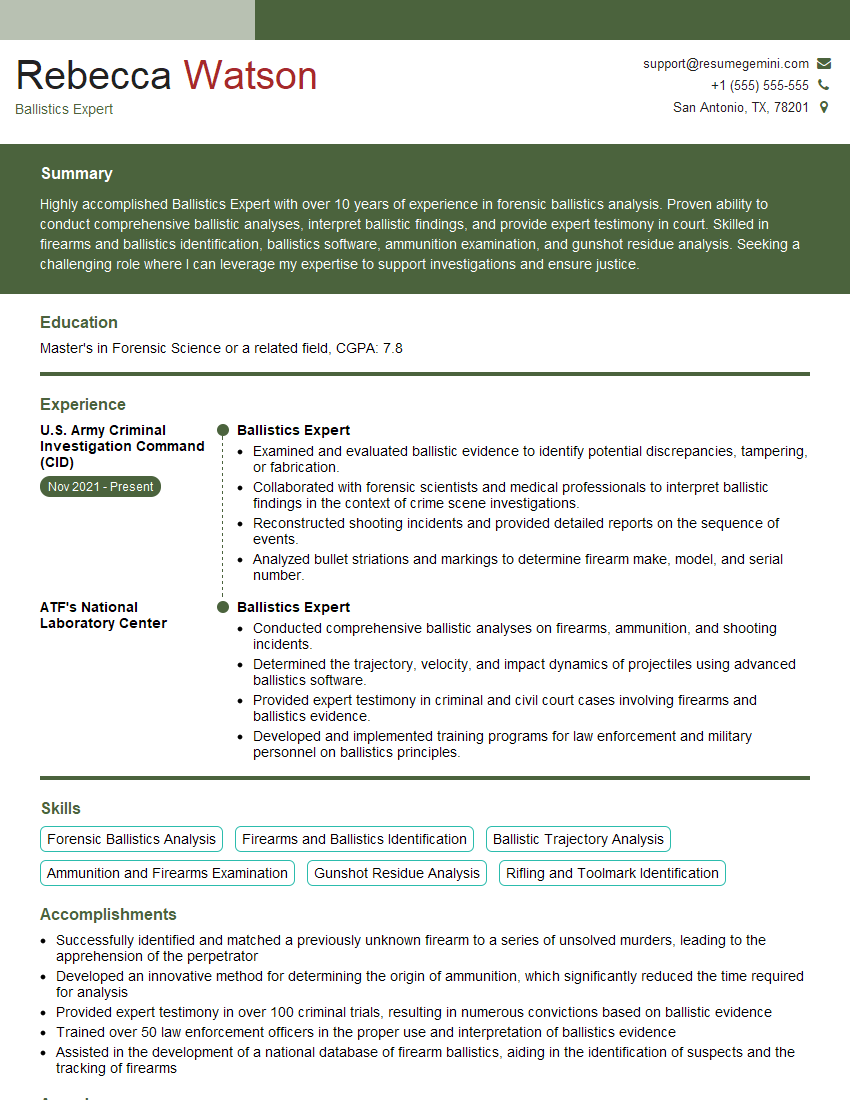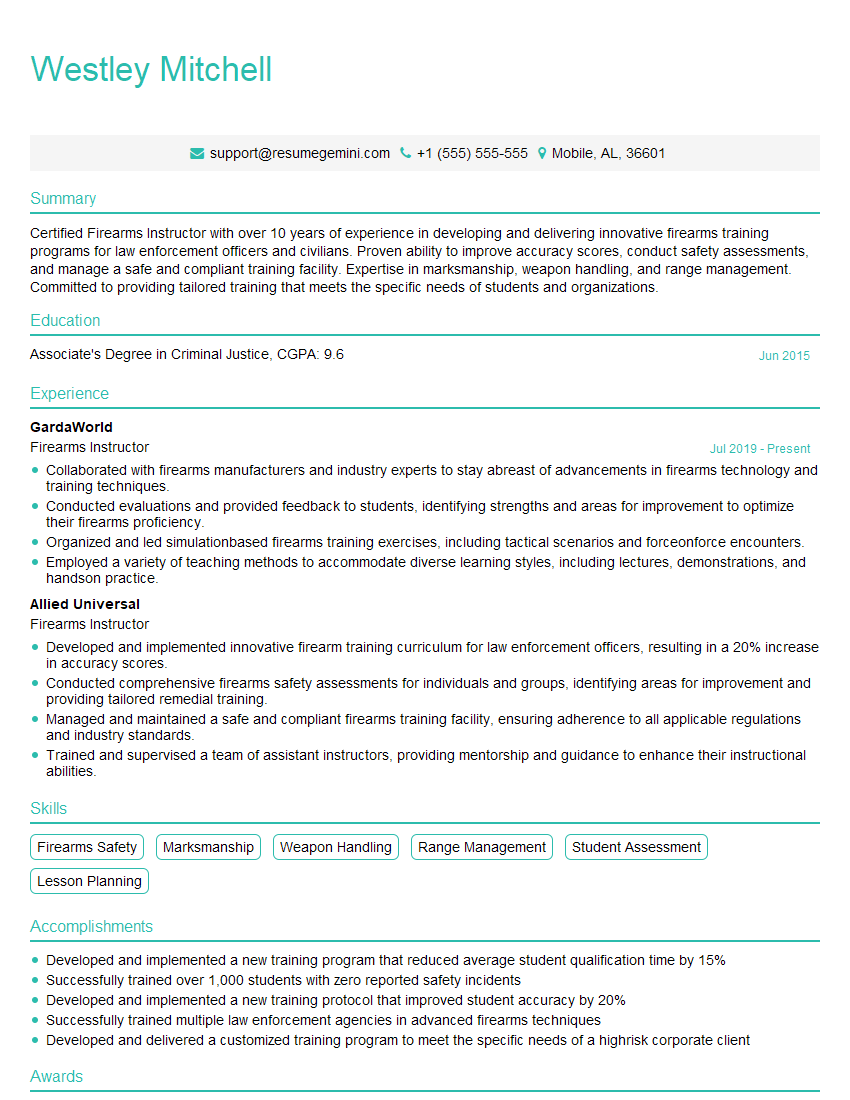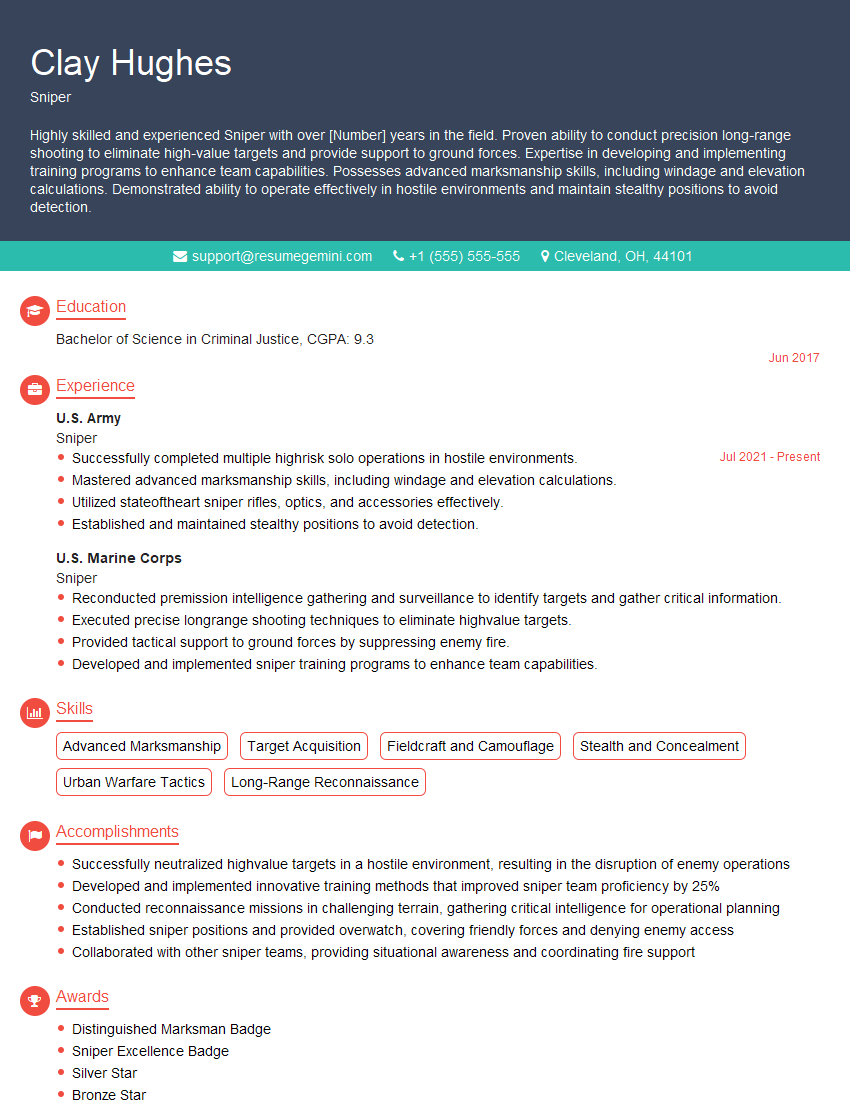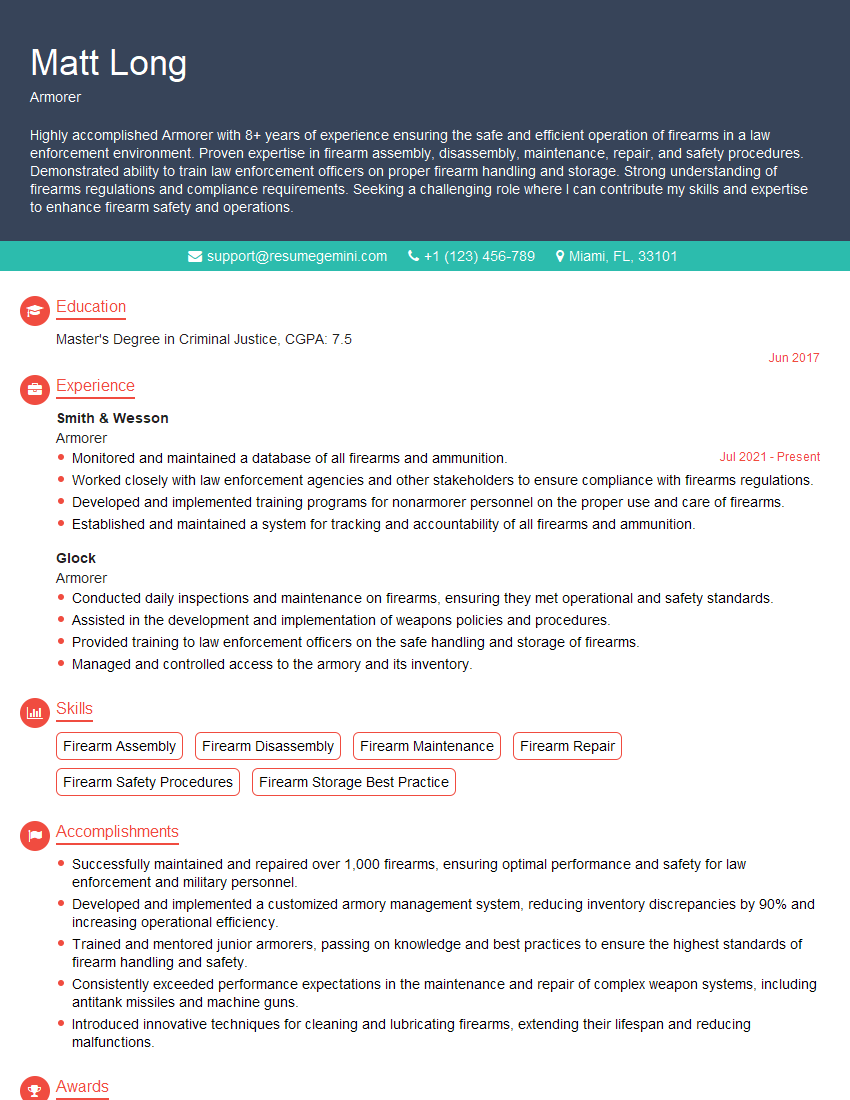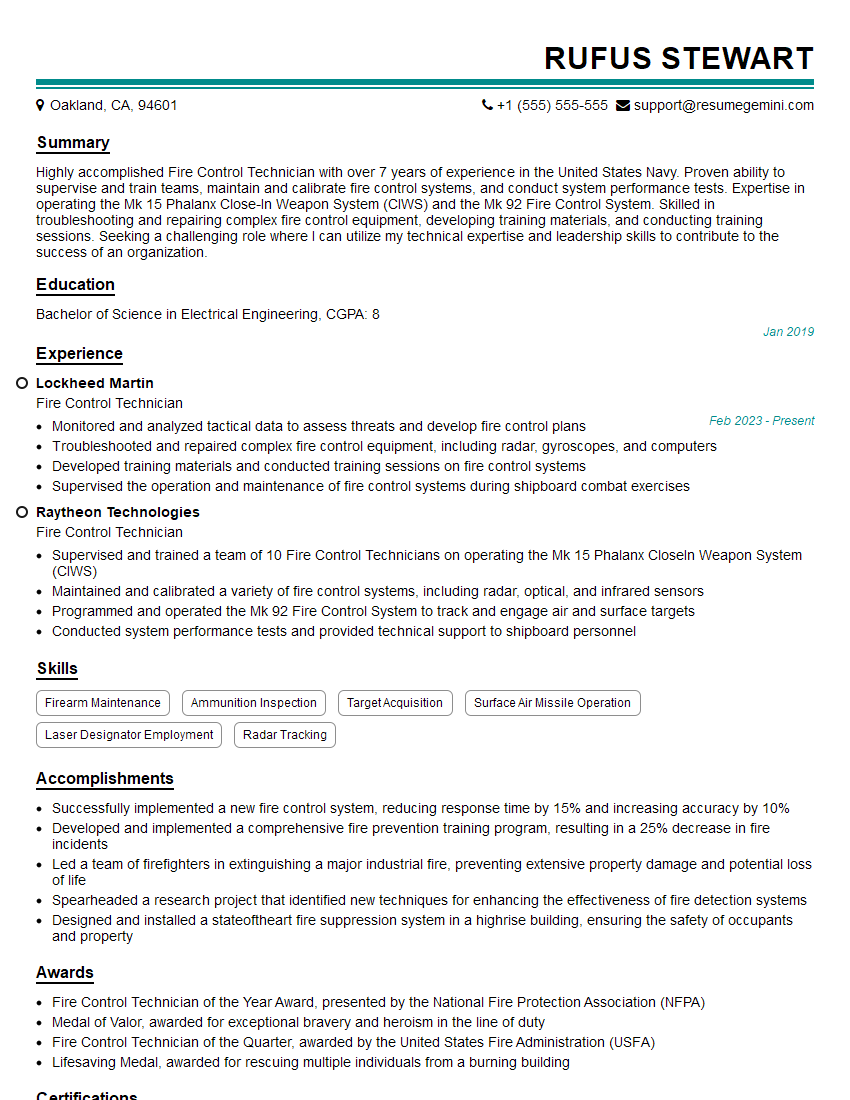Are you ready to stand out in your next interview? Understanding and preparing for Precision Fire Techniques interview questions is a game-changer. In this blog, we’ve compiled key questions and expert advice to help you showcase your skills with confidence and precision. Let’s get started on your journey to acing the interview.
Questions Asked in Precision Fire Techniques Interview
Q 1. Explain the principles of external ballistics.
External ballistics is the study of a projectile’s flight from the moment it leaves the muzzle of the firearm until it impacts the target. It’s governed by several forces, primarily gravity and air resistance (drag), but also influenced by factors like the spin-stabilizing effect from rifling, the Coriolis effect (Earth’s rotation), and even wind.
Imagine throwing a baseball: gravity pulls it down, and air resistance slows it down. A bullet’s flight is similar, but far more complex due to higher velocities and the effects of spin. Understanding these forces allows us to predict a bullet’s trajectory and achieve accurate shots at various ranges.
Q 2. Describe the factors influencing bullet trajectory.
Many factors influence a bullet’s trajectory. These can be broadly categorized into:
- Ballistic Factors: These relate to the projectile itself, including its caliber, weight, shape, and the amount of powder used in the cartridge. A heavier bullet will generally resist wind drift better, while a more aerodynamic bullet will experience less drag.
- Environmental Factors: These include things like wind speed and direction, temperature (affecting air density and therefore drag), altitude (affecting air density), and humidity (slightly affecting air density).
- Weapon Factors: The firearm’s characteristics play a role; the bore diameter, rifling twist rate (affecting bullet stability), and the muzzle velocity all influence trajectory.
- Shooter Factors: While seemingly less obvious, shooter error is a significant factor. Consistent aiming and trigger control are critical, as are proper body positioning and breathing techniques.
For example, a strong headwind will push a bullet downward and to the side, whereas a crosswind will cause it to drift laterally. Higher altitudes, with thinner air, reduce drag and can extend the range, while temperature fluctuations also impact the bullet’s speed and trajectory.
Q 3. What are the different types of aiming systems and their advantages/disadvantages?
Several aiming systems exist, each with advantages and disadvantages:
- Iron Sights: Simple, reliable, and lightweight. Disadvantages include limited precision at longer ranges and a less intuitive sight picture for some shooters.
- Optical Sights (Scopes): Offer magnification, providing clearer target acquisition and greater precision at longer ranges. However, they are heavier, more expensive, and can be more fragile than iron sights. Different types exist, including fixed power scopes, variable power scopes, and telescopic sights.
- Red Dot Sights: Project a small illuminated dot onto the target, offering a fast sight acquisition and good performance in low-light conditions. They lack magnification, limiting their effectiveness at longer ranges.
- Laser Sights: Project a visible laser beam onto the target, aiding quick target acquisition. However, they are highly susceptible to environmental interference and are often considered less precise than other aiming systems.
The best choice depends on the specific application. For long-range precision shooting, a quality optical scope is preferred. For close-quarters combat or hunting situations where speed is critical, a red dot sight might be more suitable.
Q 4. How do you compensate for wind drift?
Compensating for wind drift requires understanding wind speed and direction, and the bullet’s trajectory. Experienced shooters often use wind flags or wind meters to assess wind conditions. The compensation itself is made by adjusting the aiming point, leading the target (aiming ahead of the target’s movement) into the wind. The amount of lead required depends on the wind speed, range, and the bullet’s ballistic coefficient.
There isn’t a single formula; experience and practice are crucial. A 10 mph crosswind at 300 yards might necessitate a significant adjustment, while the same wind at 100 yards would require a much smaller correction. Mil-dot reticles on scopes are designed to aid windage estimations at different ranges. Many shooters also rely on wind charts and their own detailed range records to refine their techniques.
Q 5. Explain the concept of zeroing a rifle.
Zeroing a rifle means adjusting the sights so the point of impact (POI) of the bullet matches the point of aim (POA) at a specific range. Typically, this is done at 25 yards and again at 100 yards (or 50 and 100 meters in metric systems). The process ensures the bullet consistently hits where the sights are aligned at that distance, providing a consistent point of impact for precision. A common zeroing is to achieve a ‘battle zero’ with similar impacts around 25 and 200-300 meters.
Think of it like calibrating a scale: you adjust the weights until the indicator accurately shows the correct weight. Similarly, zeroing a rifle ensures your aiming system is accurately aligned with the bullet’s flight path.
Q 6. Describe the process of sighting in a weapon.
Sighting in (or zeroing) a weapon involves a series of steps:
- Set up a safe shooting environment: Ensure a backstop and appropriate safety measures are in place.
- Choose your target: A target with distinct aiming points at different ranges is ideal.
- Fire a few test shots: Note the point of impact relative to the point of aim.
- Adjust the sights: Use the adjustments on the sights (elevation and windage) to correct the point of impact. Typically, you would adjust the sight in small increments, and then re-test until you are happy.
- Repeat as necessary: Continue the process of shooting, observing, and adjusting until you achieve the desired zero.
This process requires patience and careful observation. Small adjustments can make a significant difference in accuracy, and meticulous record-keeping of each shot can significantly aid your process.
Q 7. What are the different types of ammunition and their applications?
Ammunition types vary considerably based on intended use. Some key categories include:
- Full Metal Jacket (FMJ): A copper or brass-jacketed bullet with a lead core. Common for military and target shooting due to its good penetration and consistent performance. Not ideal for hunting due to over-penetration risk.
- Hollow Point (HP): A bullet with a hollow cavity in the tip. Designed to expand upon impact, causing more significant tissue damage. Frequently used for hunting and self-defense.
- Soft Point (SP): Similar to HP but with a softer lead core that expands more predictably. Also a popular choice for hunting.
- Armor Piercing (AP): Bullets specifically designed to penetrate armor. Often have a hardened core and are generally restricted.
- Subsonic Ammunition: Designed to travel at speeds below the speed of sound, minimizing noise. Useful for hunting or law enforcement to avoid compromising location or scaring away game.
The choice of ammunition depends heavily on the context and legal restrictions. Selecting inappropriate ammunition can lead to legal ramifications or endanger others.
Q 8. How do you determine the correct ammunition for a specific situation?
Choosing the right ammunition is paramount in precision fire. It’s not a one-size-fits-all situation; the ideal round depends heavily on the target, the environment, and the weapon system. We consider several factors:
- Target Type: Hard targets like armored vehicles require armor-piercing rounds. Soft targets like personnel might utilize expanding rounds for increased stopping power. For example, a .308 Winchester with a match-grade, boat-tail hollow point would be suitable for a medium-sized soft target at moderate range, providing accuracy and reliable expansion. A heavier, armor-piercing round would be needed for a vehicle.
- Range: Longer ranges demand ammunition with better ballistic coefficients – meaning it retains velocity and accuracy over distance. At shorter ranges, this is less critical.
- Environmental Conditions: Wind, temperature, and humidity all impact trajectory. Knowing these factors helps predict bullet drop and drift and allows for appropriate compensation. For instance, high altitude and temperature require adjustments to compensate for reduced air density.
- Weapon System: The firearm itself dictates compatible ammunition. Using incorrect ammunition can damage the weapon or lead to malfunctions. Always consult the firearm’s manual.
The selection process often involves testing different ammunition types under controlled conditions to determine optimal performance for specific scenarios. This ensures the most accurate and effective shot placement.
Q 9. Explain the importance of proper trigger control.
Proper trigger control is the foundation of accurate shooting. It ensures a smooth, consistent pull, minimizing unwanted movement that can affect shot placement. Think of it as the final, most delicate step in a carefully orchestrated sequence.
- Consistent Pressure: The trigger should be squeezed smoothly and consistently, like slowly squeezing a toothpaste tube, avoiding any jerking or anticipation. This prevents the firearm from moving unpredictably during the shot.
- Avoiding Slapping or Yanking: A quick, forceful pull (slapping) or anticipating the recoil (yanking) will throw off your aim and drastically reduce accuracy.
- Proper Grip: A firm but relaxed grip minimizes movement during recoil. It’s about control, not squeezing with all your might.
- Follow Through: Maintaining proper sight alignment and trigger finger pressure even after the shot prevents unintended movement and ensures the shooter remains focused on the target.
Improper trigger control is the single most common cause of poor accuracy. It’s a skill honed through constant practice and conscious effort.
Q 10. What are the safety procedures for handling firearms?
Firearm safety is paramount. The cardinal rule is to always treat every firearm as if it were loaded. This mindset prevents accidents.
- Treat Every Weapon as Loaded: Never assume a weapon is unloaded. Always check for yourself.
- Keep Your Finger Off the Trigger Until Ready to Shoot: This prevents accidental discharges.
- Point the Weapon in a Safe Direction: Always point the weapon in a direction where a misfire would cause no harm.
- Be Sure of Your Target and What is Beyond It: Understand your surroundings and potential risks before firing. Never shoot at moving targets unless you can confidently assure there’s no risk of collateral damage.
- Unload and Clear Firearm Before Handling, Cleaning, or Transport: Always follow the correct procedures to ensure the firearm is safe.
- Store Firearm Properly and Securely: Firearms should be stored in a locked location, inaccessible to unauthorized individuals.
These rules should be ingrained in every shooter. They are not suggestions; they are life-saving measures.
Q 11. Describe the different shooting positions and their advantages/disadvantages.
Different shooting positions offer varying degrees of stability and concealment. The choice depends on the situation and the shooter’s preference.
- Prone: Provides maximum stability, ideal for long-range precision. Disadvantage: Slow to transition to different positions.
- Kneeling: Offers a good balance of stability and speed. Disadvantage: Can be less stable than prone, especially on uneven terrain.
- Sitting: Relatively stable, allows for quick transitions to other positions. Disadvantage: Less stable than prone or kneeling.
- Standing: Fastest to transition but least stable. Disadvantage: Highly susceptible to wind and body movement; requires excellent technique.
- Supported: Utilizing a barricade or other support for added stability. Advantage: Increases accuracy significantly, especially in standing positions. Disadvantage: Requires suitable support, and the shooter must effectively manage their positioning on the support to prevent it from interfering with the aim.
Practicing each position is crucial for developing a solid understanding of their strengths and limitations.
Q 12. How do you maintain a weapon’s accuracy?
Maintaining weapon accuracy is a multifaceted process. It involves several key steps:
- Regular Cleaning: A clean weapon functions correctly and reliably. Accumulated fouling can affect accuracy.
- Proper Lubrication: Lubrication reduces friction and ensures smooth operation.
- Ammunition Selection: Consistent, high-quality ammunition is essential. Avoid ammunition with defects or inconsistencies.
- Sight Alignment and Adjustment: Properly aligned sights are crucial for accuracy. Adjustments may be needed to compensate for zeroing or environmental conditions.
- Regular Maintenance: Occasional professional servicing can identify and address potential issues before they impact accuracy.
- Consistent Shooting Technique: Repetitive practice, focused on fundamental skills, strengthens the shooter’s muscle memory and refines accuracy.
Neglecting any of these aspects can negatively impact accuracy. A well-maintained weapon is a prerequisite for precision shooting.
Q 13. Explain the concept of shot placement and its importance.
Shot placement is the precise location where the projectile impacts the target. It’s the most crucial aspect of effective shooting, regardless of the weapon or ammunition used.
In precision fire, we emphasize targeting vital areas – those that will quickly incapacitate the target. The specific area targeted varies depending on the threat level and circumstances; however, for soft targets, the most effective shot placement is often the central nervous system or major blood vessels. For hard targets, shot placement will focus on points that are likely to compromise the hard structure and cause failure.
Understanding anatomy and target acquisition is essential for effective shot placement. Poor shot placement can mean the difference between mission success and failure, or even life and death.
Q 14. What are the common causes of inaccurate shooting?
Inaccurate shooting stems from a variety of factors; often, it’s a combination of issues rather than a single cause.
- Improper Trigger Control: Jerky or inconsistent trigger pulls are the most common cause of inaccuracy.
- Poor Sight Alignment: Failing to maintain proper sight picture can lead to significant misses.
- Incorrect Stance: Unstable or unsupported stances compromise accuracy.
- Environmental Conditions: Wind, temperature, and humidity affect bullet trajectory.
- Ammunition Issues: Inconsistent or low-quality ammunition can produce erratic results.
- Weapon Malfunction: A faulty weapon can lead to inaccurate shots. Regular maintenance is key here.
- Improper Breathing: Holding your breath or breathing erratically can disrupt aim.
- Lack of Practice: Consistent practice is essential to hone skills and refine technique.
Troubleshooting inaccurate shooting involves systematically examining each of these factors. Addressing the root cause is essential for improvement. A good shooter practices regularly to build muscle memory and to adapt to different conditions and firearm configurations. They are not only proficient in the basics but also in diagnosing and resolving shooting issues.
Q 15. How do you diagnose and correct malfunctions?
Diagnosing and correcting malfunctions requires a systematic approach. It begins with understanding the weapon’s operating mechanism. For example, a malfunction in an AR-15 platform might manifest as a failure to feed, failure to fire, or a failure to eject. My diagnostic process starts with observing the immediate issue – did the weapon cycle fully? Was there a click, or was it completely silent? Then, I perform a series of checks following the acronym STOP: Safety (is the weapon on safe?), Trigger (is it functioning correctly?), Obstruction (is there debris in the action?), Position (is the ammunition properly seated?).
If the problem persists after this initial check, I move to a more detailed breakdown, systematically examining each component: First, checking the magazine for proper seating and ammunition integrity; then, inspecting the bolt carrier group for proper function, lubrication, and cleanliness; and finally, examining the barrel for obstructions. Depending on the firearm, a malfunction may require simple clearing, such as tapping the magazine, or a complete field strip and cleaning. In many instances, I use a ‘tap, rack, and assess’ method for quick resolution during a tactical situation (covered in the next question). Detailed record-keeping of these malfunctions and their solutions is crucial for improving future performance and preventative maintenance.
Career Expert Tips:
- Ace those interviews! Prepare effectively by reviewing the Top 50 Most Common Interview Questions on ResumeGemini.
- Navigate your job search with confidence! Explore a wide range of Career Tips on ResumeGemini. Learn about common challenges and recommendations to overcome them.
- Craft the perfect resume! Master the Art of Resume Writing with ResumeGemini’s guide. Showcase your unique qualifications and achievements effectively.
- Don’t miss out on holiday savings! Build your dream resume with ResumeGemini’s ATS optimized templates.
Q 16. How do you handle a weapon malfunction in a tactical situation?
Handling a weapon malfunction in a tactical situation demands swift and decisive action. Speed and safety are paramount. My training emphasizes a methodical approach that prioritizes safety first. Think of it like this: you can’t fix a problem if you’re injured. The first step is to assess the immediate threat. If I’m under fire, I’ll take cover and prioritize self-preservation before attempting any repairs. If possible, I’ll use cover to create space for immediate action. Often, in a stressful scenario, the malfunction is due to a simple issue like a faulty magazine or a round that hasn’t fully seated. I’ll usually employ a ‘tap, rack, and assess’ technique: Tap the magazine to ensure it’s seated properly, Rack the charging handle to clear any obstructions, and Assess the situation to see if the problem is resolved. If it isn’t, I’ll move to secondary weapon systems or other tactical solutions like calling for support.
If the malfunction persists despite this, I will execute a tactical reload as quickly and efficiently as possible. In extreme circumstances, this may involve transitioning to a backup weapon. The critical element here is maintaining situational awareness at all times. My experience includes numerous dry fire drills that simulate high-pressure situations, helping to train muscle memory for rapid, correct responses in less-than-ideal circumstances. The time spent on training is invaluable in ensuring smooth execution under pressure.
Q 17. Describe your experience with different types of scopes and optics.
My experience with scopes and optics spans various types and applications. I’ve worked extensively with red dot sights, holographic sights, low-power variable optics (LPVOs), and high-power fixed magnification scopes. Red dot sights are ideal for close-quarters combat (CQB) because of their speed and ease of target acquisition. Holographic sights offer similar advantages and greater ruggedness. LPVOs, like the 1-6x or 1-8x models, provide versatility, suitable for both CQB and longer-range engagements. They offer excellent close-range performance with the added capability to reach out further than a red dot. High-power fixed scopes, typically 10x or higher, are primarily used for long-range precision shooting, requiring accurate range estimation and compensation for environmental factors.
I’m also proficient with night vision and thermal optics, understanding their capabilities and limitations in different conditions. Experience with various mounting systems and zeroing procedures for these optics is equally essential. For example, I’ve used ACOGs extensively in close-to-medium range engagements, and the precision of the reticle provides a significant advantage for quick shots.
Q 18. How do you choose the right optic for a specific task?
Choosing the right optic depends heavily on the intended task. The most critical factors are the anticipated engagement distances and the shooting environment. For CQB scenarios, a red dot sight or holographic sight prioritizes speed and ease of target acquisition. LPVOs strike a balance between close and mid-range capabilities, making them suitable for a wider range of scenarios. For long-range shooting, high-magnification scopes are necessary, but they come with a tradeoff in speed and weight.
Other considerations include the shooter’s personal preferences, budget, and environmental factors such as lighting conditions. For example, a low-light environment might necessitate night vision or a sight with enhanced illumination capabilities. Furthermore, the firearm platform itself can influence optic selection. The weight and size of the optic must be compatible with the platform to maintain balance and maneuverability. Careful consideration of these factors ensures optimal performance and an advantage in any operation. Often, an individual’s skillset and proficiency with a particular optic also play a role in making the final decision.
Q 19. Explain the concept of lead and how it’s calculated for moving targets.
Lead is the anticipation of a moving target’s future position to compensate for the projectile’s travel time. Calculating lead is a dynamic process influenced by several variables: target speed, target direction, range to target, and projectile velocity. A simple way to visualize it is to imagine throwing a ball at a moving car. You wouldn’t throw the ball directly at where the car currently is; you’d throw it ahead of where you expect the car to be when the ball arrives. The further the target, the more lead is required.
Precise lead calculation is difficult and rarely done using mathematical formulas in the field. Instead, lead is primarily estimated through practice and experience. Factors such as the target’s trajectory and speed are judged visually, and then adjustments are made through trial and error during live-fire practice. Improved lead estimation comes from consistent practice with various speeds and distances.
Q 20. Describe your experience with range estimation techniques.
I have extensive experience in various range estimation techniques, both using tools and making visual estimations. These include using rangefinders (laser and stadiametric), as well as employing visual estimation techniques. The use of a rangefinder is straightforward, but environmental conditions can affect accuracy. Stadiametric rangefinding, using a reticle with known mil-dots or similar markings, involves measuring the apparent size of the target in the scope’s reticle and applying mathematical formulas. This method requires precise measurements and familiarity with the scale of the reticle.
Visual estimation is more challenging and relies on experience and knowledge of the target’s size. Knowing the approximate size of a target (e.g., a person, a vehicle) allows an estimation of its distance based on its apparent size in the field of view. This technique is crucial in situations where rangefinders are unavailable or impractical to use. I regularly practice these techniques, constantly refining my ability to estimate distances accurately. Knowing your limitations with each method and relying on the most appropriate techniques in different situations is key to success.
Q 21. How do you account for environmental factors such as temperature and altitude?
Environmental factors significantly impact projectile trajectory. Temperature affects the density of the air, influencing the bullet’s drag and therefore its velocity and trajectory. Higher temperatures typically mean lower air density, resulting in a flatter trajectory. Conversely, lower temperatures mean higher density, leading to a more curved trajectory. Altitude also affects air density; lower air density at higher altitudes results in flatter trajectories, similar to the effect of higher temperatures.
Accounting for these factors often involves using ballistic calculators or software that takes into account the specific ammunition, environmental conditions, and firearm characteristics. Such programs generate data showing the precise trajectory adjustments required. In the field, without access to sophisticated tools, compensation for these factors may rely on experience and estimation, incorporating learned adjustments based on the conditions.
For example, my experience in high-altitude, cold environments has taught me to compensate for the higher air density resulting in a drop in bullet velocity at longer ranges. This is a crucial aspect of precision shooting, where even small errors in accounting for these factors can result in significant misses at distance.
Q 22. What is your experience with different types of range finders?
My experience with range finders spans across various technologies and applications. I’m proficient with both laser range finders and stadiametric range finders. Laser range finders, offering precise distance measurements with a simple push of a button, are invaluable for long-range shooting where accuracy is paramount. However, they can be affected by atmospheric conditions and target reflectivity. Stadiametric range finders, using a reticle in the scope and known target dimensions, offer a backup method, requiring more calculation but proving resilient to environmental factors. I’ve extensively used both in diverse terrains, from open fields to heavily wooded areas, adjusting my techniques accordingly to account for potential errors and environmental interference. For example, in a dense forest, the laser range finder might struggle to obtain a clear reading, whereas stadiametric ranging, though more time-consuming, offers a reliable alternative.
Q 23. Explain the importance of respiratory control in precision shooting.
Respiratory control is fundamental to precision shooting. Think of it as the unseen, yet crucial, foundation upon which accuracy is built. Each breath causes minute movements in your body, affecting your sight alignment and shot placement, especially at longer ranges. Proper breathing techniques involve controlling the rate, depth, and rhythm of your breathing to minimize these involuntary movements. A common technique is the controlled exhalation method: take a normal breath, exhale slowly and completely, and hold your breath for a moment at the point of natural breath-holding before firing. This helps stabilize your body and allows for a precise shot. I’ve found consistent practice of respiratory control exercises crucial in significantly improving shot grouping and reducing shot dispersion.
Q 24. How do you maintain situational awareness while engaging targets?
Maintaining situational awareness is about more than just focusing on the target; it’s a 360-degree awareness of your surroundings. It involves constantly scanning your environment, identifying potential threats (both immediate and emerging), and being prepared to react accordingly. This means continually assessing wind conditions, potential obstacles, and the movement of friendly and enemy forces. For instance, during a long-range engagement, I would regularly scan my surroundings for potential threats from flanks or rear, even while engaging a primary target. I use a systematic approach, frequently shifting my gaze between my primary target, my immediate vicinity, and the broader environment to proactively mitigate risks and ensure my safety and the success of the mission.
Q 25. Describe your experience with different types of shooting rests.
My experience with shooting rests includes various types, each suited for different scenarios and firearm types. I’m proficient with sandbags, bipods, tripods, and shooting sticks. Sandbags offer stability and adjustability, crucial for rifles and heavier firearms. Bipods are ideal for rapid target acquisition and deployment. Tripods, while offering superior stability, are often heavier and less portable. Shooting sticks are lightweight and compact, perfect for situations requiring mobility and quick setup in uneven terrain. The selection of a shooting rest always depends on the shooting situation: a prone position might necessitate sandbags for superior stability, while a hasty engagement from a vehicle could necessitate a bipod for quick deployment and target engagement. The choice is always driven by the need for stability and speed.
Q 26. Explain the procedures for cleaning and maintaining firearms.
Cleaning and maintaining firearms is a critical aspect of safe and reliable operation. It involves a methodical process to ensure optimal function and longevity of the weapon. It starts with safety—always ensure the firearm is unloaded and clear. Then, I use appropriate solvents and lubricants for the specific firearm type and caliber, meticulously cleaning each component, including the barrel, bolt, receiver, and magazine. I remove fouling, debris, and any corrosion carefully. Proper lubrication is critical to prevent wear and tear and ensure smooth operation. After cleaning and lubricating, I carefully inspect all components for damage and wear, ensuring everything is functional before securely storing the firearm.
Q 27. Describe your experience with night vision equipment.
My experience with night vision equipment involves various generations of image intensifier tubes and thermal imaging systems. I am proficient in the operation and limitations of each. Image intensifier tubes amplify ambient light, crucial for low-light conditions, but their performance degrades with increasing light levels. Thermal imaging systems, on the other hand, detect heat signatures, providing clear images regardless of light levels. Understanding the strengths and limitations of each is critical. For instance, in very dark conditions, image intensifier tubes might only provide a very faint image. Thermal imagers can give a clear image even without a moon, but can be affected by camouflage techniques which may reduce or change the heat signature. The choice between the two systems is always dependent on the specific operational environment.
Q 28. How do you handle stress and pressure in a high-stakes shooting situation?
Handling stress and pressure in high-stakes situations relies on a combination of mental and physical preparedness. Years of rigorous training have instilled a disciplined approach, focusing on the fundamentals: proper breathing, controlled movements, and a clear, concise execution of the task. I employ visualization techniques, mentally rehearsing the scenario beforehand to reduce uncertainty and improve performance. Maintaining self-awareness is critical—recognizing the onset of stress and employing coping mechanisms such as deep breathing exercises is essential. Additionally, maintaining a calm and focused demeanor, while working effectively as part of a team, significantly contributes to success under pressure. Remember, staying calm, focusing on the fundamentals, and executing the plan are all key to overcoming stress in such scenarios.
Key Topics to Learn for Precision Fire Techniques Interview
- Fundamentals of Fire Behavior: Understanding the fire triangle, heat transfer mechanisms (conduction, convection, radiation), and the influence of fuel type, oxygen supply, and ignition sources on fire spread.
- Fire Suppression Strategies: Exploring various suppression techniques including water application strategies (e.g., direct attack, indirect attack), foam application, and the use of dry chemical agents. Consider the impact of different suppression methods on specific fire types and environments.
- Tactical Considerations: Analyzing risk assessment, safety protocols, and the importance of situational awareness in precision fire techniques. This includes understanding team communication and coordination during fire suppression operations.
- Equipment Operation and Maintenance: Demonstrating knowledge of fire suppression equipment, including hoses, nozzles, pumps, and other specialized tools. Understanding routine maintenance and safety checks is crucial.
- Fire Investigation and Prevention: Basic understanding of fire investigation techniques, identifying potential fire hazards, and implementing preventative measures. This demonstrates a holistic understanding of fire safety.
- Advanced Techniques (as applicable): Depending on the specific role, you may need to delve into specialized areas such as wildland firefighting techniques, industrial fire suppression, or hazardous materials incident response.
- Problem-Solving in Fire Scenarios: Practice analyzing hypothetical fire scenarios, identifying challenges, and developing effective solutions. Consider the ethical and safety implications of your decisions.
Next Steps
Mastering Precision Fire Techniques is paramount for career advancement in this crucial field. It showcases your commitment to safety, efficiency, and expertise. To significantly boost your job prospects, create an ATS-friendly resume that highlights your skills and experience effectively. ResumeGemini is a trusted resource to help you build a professional and impactful resume that catches the eye of recruiters. Examples of resumes tailored to Precision Fire Techniques are available to help guide you through the process. Invest time in crafting a compelling resume—it’s your first impression!
Explore more articles
Users Rating of Our Blogs
Share Your Experience
We value your feedback! Please rate our content and share your thoughts (optional).
What Readers Say About Our Blog
Hello,
We found issues with your domain’s email setup that may be sending your messages to spam or blocking them completely. InboxShield Mini shows you how to fix it in minutes — no tech skills required.
Scan your domain now for details: https://inboxshield-mini.com/
— Adam @ InboxShield Mini
Reply STOP to unsubscribe
Hi, are you owner of interviewgemini.com? What if I told you I could help you find extra time in your schedule, reconnect with leads you didn’t even realize you missed, and bring in more “I want to work with you” conversations, without increasing your ad spend or hiring a full-time employee?
All with a flexible, budget-friendly service that could easily pay for itself. Sounds good?
Would it be nice to jump on a quick 10-minute call so I can show you exactly how we make this work?
Best,
Hapei
Marketing Director
Hey, I know you’re the owner of interviewgemini.com. I’ll be quick.
Fundraising for your business is tough and time-consuming. We make it easier by guaranteeing two private investor meetings each month, for six months. No demos, no pitch events – just direct introductions to active investors matched to your startup.
If youR17;re raising, this could help you build real momentum. Want me to send more info?
Hi, I represent an SEO company that specialises in getting you AI citations and higher rankings on Google. I’d like to offer you a 100% free SEO audit for your website. Would you be interested?
Hi, I represent an SEO company that specialises in getting you AI citations and higher rankings on Google. I’d like to offer you a 100% free SEO audit for your website. Would you be interested?
good
